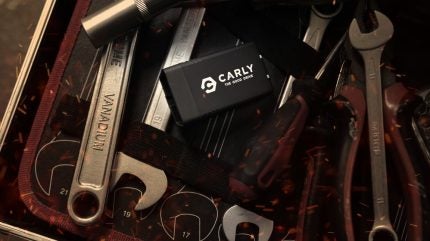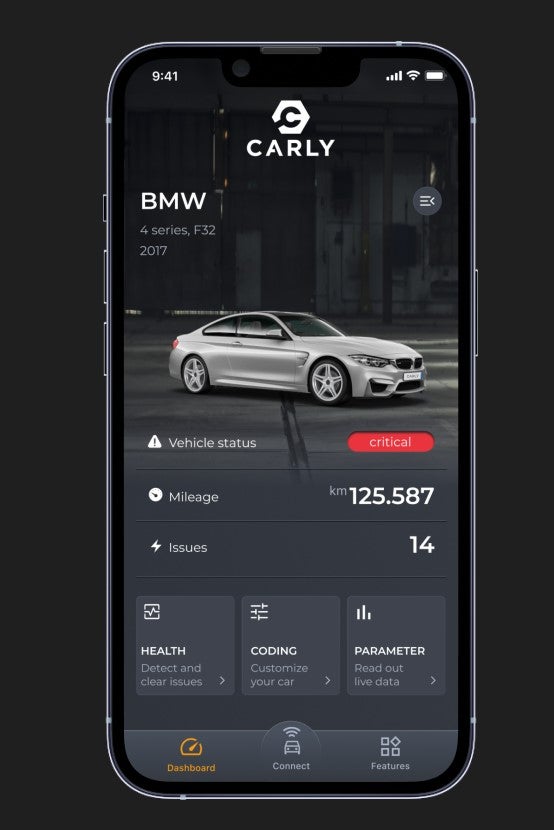
Car owners are becoming the forgotten piece in vehicle maintenance, with many simply taking their car to a garage when any issue comes up. Could on-board diagnostics (OBD) technology help?
Engine warning lights, strange noises, clunky driving – a car owner’s nightmare of undiagnosed faults and unknown repair needs ahead. Issues with your vehicle can start to spiral into stress and anxiety around what the causes could be, potential fix costs and repair timelines.
What if these stresses and fears could be managed? Cartech company, Carly, connects drivers with information that is hidden in their vehicles via an on-board diagnostics (OBD) device.
Once plugged in and connected the scanner provides general diagnosis, battery life information, live data, and maintenance information – allowing users to better manage maintenance needs.
We spoke to Dan Meeghan, UK country manager, Carly, to learn more about the company and the benefits the technology can offer to car owners and mechanics.

Just Auto (JA): How did the company come to be?
How well do you really know your competitors?
Access the most comprehensive Company Profiles on the market, powered by GlobalData. Save hours of research. Gain competitive edge.

Thank you!
Your download email will arrive shortly
Not ready to buy yet? Download a free sample
We are confident about the unique quality of our Company Profiles. However, we want you to make the most beneficial decision for your business, so we offer a free sample that you can download by submitting the below form
By GlobalDataDan Meeghan (DM): The company was first started in 2012. One of our founders had a BMW 7-Series back then. He took it into a garage because he was having issues with the gearbox. It turned out these issues in the gearbox we’re going to cost him around 12,000 euros after diagnosis from the garage. At the time, he decided that was a ridiculous sum and wanted to know more about the process of diagnostics.
Some Bluetooth OBD scanners were obtained, plugged into the car and it was quickly possible to interrogate the vehicle’s ECU to find out what was going on with the vehicle.
After investigation and a bit of back and forth on the Internet, it was discovered that the fault with the car centred on an $80 part.
The next step was to set up the business. It began with BMW as the focus brand in Germany. A basic product platform was built and they also had real-time users in Germany on the vehicle forums who were sending it out to get all the car owners to test it.
From there, it started to get a bit of momentum; they then decided on a price for a commercial product, got it validated and the business was born.
What is the ‘Smart Mechanic’ feature on the app?
The motor industry is obviously not like it was back in the 1990s where you’re checking your points, manually checking distributor caps and everything else. Everything now is electronic with centralised electronic systems.
Garages now spend large sums on diagnostic equipment just to be able to do their jobs. These specialist systems are pretty phenomenal, but they are also extremely complicated. You need to be very highly trained to be able to understand them and use them properly.
Garages now spend large sums on diagnostic equipment just to be able to do their jobs.
What we’ve done is simplify. We have taken the experience from a team about 40 mechanics in total and we’ve distilled much data from all the fault codes. The mechanics have written our Smart Mechanic guides based on experienced mechanics’ data and trimmed it down to a general consumer level so that it makes it understandable for every car owner, not just the professional mechanics. It is, effectively, putting it into plain language – simplifying where we can.
What are some key benefits the technology offers?
The biggest mission that we’re on is to give back control to the car owner. Car owners are becoming the forgotten piece when it comes to vehicle maintenance and repair. Everything has been centralised into car dealerships and garages and the information is not naturally being pushed out openly.
What we’re aiming to do is to give back some control to the car owner with the data and information in the car coming back to the owner. Giving you access to that information allows you to be more proactive and take back control of your car maintenance lifecycle.
What we’re aiming to do is to give back some control to the car owner with the data and information in the car coming back to the owner.
If you’re plugging in regularly, and you’re watching what is coming up on your car, you’re able to then start prioritising what you need to do and when. You can start to proactively manage your car maintenance. You don’t have to do it all in one go. You can start to think: “What do I need to fix first? What’s going to be the most expensive to correct or fix? Can I start planning the maintenance?”
The ultimate thing is that we’re even able to help people do some of this work themselves if they want to. With the Smart Mechanic feature, we can show people how to do the work and show them how to do the basic maintenance. It’s not about getting everybody to fix their own cars themselves of course. What it’s about is giving people more information so that they are in a position to make an informed decision about what comes next.
It gives people more choice. It also gives them much more transparency. We’re giving them information on what the systems are, how they work, the symptoms of problems to look out for and so on. When they do go and seek professional help, they can have an informed conversation with a mechanic and that mechanic will appreciate the fact that now they’re having a conversation with somebody who’s got some relevant information and knowledge. It’s not as asymmetric in terms of who has the relevant information as is typically the case.

What are some additional benefits the technology offers mechanics?
Garages actually love it because it improves their efficiency. The worst thing in a workshop is to find that after a car is on a ramp and stripped down, a critical part is missing. The workshop can easily get backed up with vehicles waiting for a part.
All of a sudden, you’ve got a garage that’s very full and working to absolute capacity, and then you get two or three customers coming in with car issues and you’re talking to them saying that their problem can’t be looked at until next week.
A better scenario and outcomes can come with a more informed customer who’s in a position to know the issues that are coming up more regularly; it means they can start to be more proactive. They can go and speak to the garage and say: “I’ve had this fault coming up, it’s come up two or three times over the last couple of months.”
You can quickly have that conversation with mechanic or workshop manager; they will be able to diagnose it quickly to say what it is. It can create a five-minute job opposed to a two-hour job – it just makes it easier to manage.
Why do you think this technology is not as well-known as it could be?
OBD technology really started came into play seriously in the year 2000. Just before that it was pretty primitive (in the days when the Nokia 33 was the biggest selling cell phone). The technology wasn’t amazing at the time.
For about six or seven years, while technology really started to embed itself into cars, technology moved on. OBD had a bit of a bad ride with early attempts. Anybody who tried it in those first few years probably thought ‘well this is no good, I’d rather just go to a garage’.
It’s different now when the cars have got up to 80 ECUs; they constantly talk to every part of the car so it’s effectively a case of one central nervous system that can manage every other part of the vehicle’s systems. The capabilities of the technology are now 100 times what they were just ten years ago. It’s phenomenal what the cars are capable of.
This isn’t as difficult as it used to be in terms of the interface with user. With a very simple device like ours you can understand more of what’s really going on in your car.
How does the subscription model work?
You can go to our website and find your brand of car; it will tell you exactly what is compatible. The biggest thing to remember is that every different vehicle brand, make and model is different. We’re able to clearly give you exactly what’s available.
If you want to go with a subscription service, it starts at £55. That gives you the full access to all the premium information which gives you the manufacturer level diagnostics, all the live data, and the used car checks.
Smart Mechanic is the only extra. If you’re an experienced mechanic, you probably don’t need it because it’s going to tell you what you already know. However, if you’re not that experienced, Smart Mechanic has guides, repair guides, hints and tips that cover over 6,000 of the most common fault codes. It’s an enormous amount of data.
You can go for a single brand; if you just have BMWs in the household, you can get a single brand. Or you can have all brands which will cover every make and model on the road – that is for people who have multiple brands in the household or family.







